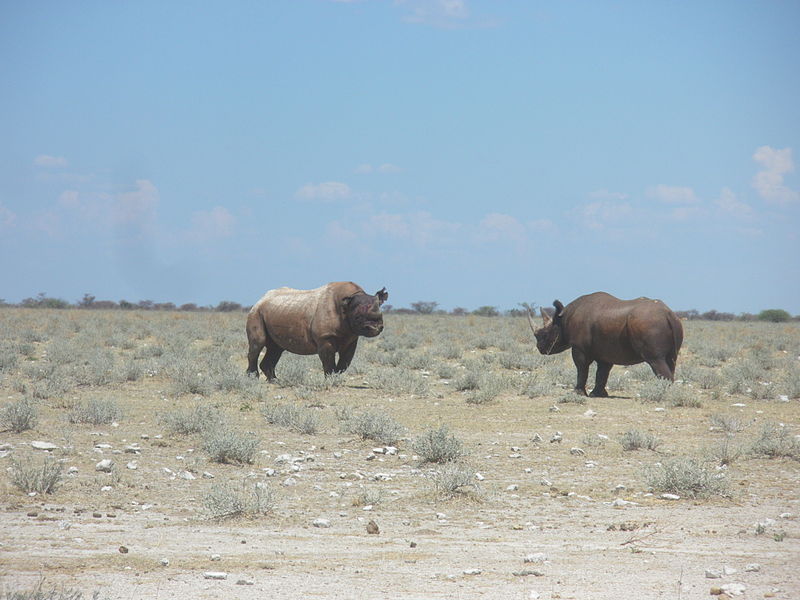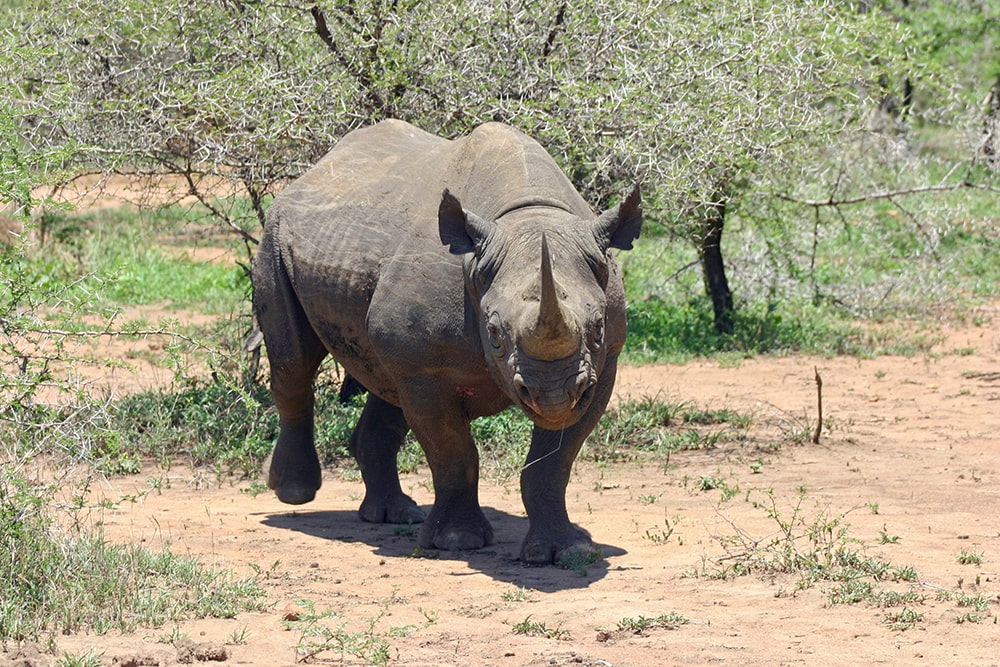Sound awkward… that to save the black rhinoceros you have to resort to trophy hunting!
The Namibian government brought back into the news headlines, the controversy about rhinoceros hunting. They sold two hunting permits through an international auction. As a result, two wealthy American hunters bought the permits.
To further fuel the controversy, the US Fish and Wildlife Service authorized the import of their hunting trophies into the US!
The Dallas Safari Club sold one of the permits for 350,000 USD to the trophy hunter, Corey Knowlton.
One of the tools available within the conservationists’ toolbox is hunting the black rhinoceros to bankroll wildlife conservation. In other words, it is okay to sacrifice a few rhinos for the better good of the rest of the population!
The Critically Endangered Black Rhinoceros
The black rhinoceros live in South Africa, Namibia, Zimbabwe, and Kenya.
The black rhino is at extremely high risk of extinction, hence classified as critically endangered. In the 1970s, the population of black rhinos in Africa was around 70,000.
A dramatic decline occurred between 1970 to 1995. It hit rock bottom in 1995 when the number of rhinoceros was 2,410! A spectacular decline of 96% of their population in a quarter of a century!
What Are the Reasons for the Population Decline of Black Rhinoceros?
One of the contributing factors to the decline of the black rhino population is the loss of habitat. However, this is not the main reason for the dramatic decrease in their numbers.
The biggest and most formidable threat to the black rhinoceros is by far: POACHING. What is the driving force behind rhinoceros poaching? Very high demand for rhino horns! On the black market, the rhino horns value is about 60,000 USD per kilogram (30,000 USD per pound).
Why are the rhino horns in such high demand? This all goes back to Asia, more specifically to China. The Chinese use the rhino horns for ornamental and medicinal purposes. The horns are used to treat high fever, for detoxification, and as an aid for male stamina and fertility.
In Vietnam, rhino horns have been used as a cancer remedy. However, none of the medical claims attributed to the rhino horns have ever been confirmed by scientific studies.
The Middle East is another region where rhino horns are quite popular. The horns are used to make the handles of ceremonial daggers called Jambiyas.
Rhinoceros poaching is a well-established and lucrative business. Poachers have been extremely active in recent years, and the numbers are staggering.
According to the organization Save the Rhino, in 2015, 1,338 rhinoceros were killed all across Africa!
From this number, 1,175 of the rhinos slaughtered were in South Africa!

Furthermore, the poachers tend to target young breeding rhinos, affecting the population growth directly. So, poaching is the main culprit in the catastrophic decline of the rhino population.
Thus, how to end poaching, which is a real threat to wildlife conservation efforts!
Black Rhinoceros Conservation Strategy in Namibia
An International organization was founded in 1973 to help protect endangered species from extinction. It is called the CITES: Convention on International Trade in Endangered Species.
Namibia put in place a conservation strategy to salvage the black rhinoceros from extinction during the 1990s. The goal is to increase the population by a minimum of 5 % annually.
In 1997, the Namibian government created the Game Products Trust Fund (GPTF). The GPTF’s money comes from rhinoceros hunting, tourism, and hunting concessions. The Trust Fund is used to finance the wildlife conservation programs.
What? Trophy Hunting Helps Wildlife Conservation!
Since 2004, the responsible trophy hunting of rhinoceros has helped to finance wildlife conservation initiatives.
The criteria for the selection of rhinos for trophy hunting are as follows:
- Five old males.
- Non-breeding.
- Dominant males.
- Aggressive and territorial, both of which have a detrimental effect on the rhino population.
The removal of old and aggressive rhinos makes more room for the younger and less dominant males to mate. Therefore, this responsible trophy hunting helps increase the rhino population.
The strategies put in place by Namibia, and South Africa have more than doubled the black rhino population since 1995. Nowadays, their numbers are about 5,000. The Etosha National Park harbors the vast majority of the black rhino on the Namibian territory.
Involve the Local Community
First off, you need to convince the landowners of the benefits of wildlife conservation. This is done through financial incentives. If there are no monetary gains to be made by keeping the land for wildlife conservation, the landowner will sell it for commercial use.
One way to deter poaching is by involving the local community in the protection of the black rhino. How to achieve this goal?
By using the revenues from wildlife conservation to improve the quality of life of the community’s inhabitants. If the local economy is thriving, poaching will become less appealing as a way to earn a living.
Rhinoceros Conservation Efforts Are Expensive
The reality is that the conservation efforts of the black rhinoceros are very expensive. Why?
Here are the main reasons:
- Hiring and training of ranger patrols.
- Purchase of vehicles and also helicopters to monitor the black rhino population.
- The use of new technology to reduce poaching. The devices used include microchips and drones to help track the black rhino.
- Creation of a DNA database for the rhino horns. This database provides the DNA fingerprints of the rhino horns, which serve identification purposes. The DNA evidence helps strengthens the case for the prosecution against poachers.

Now, how to finance wildlife conservation programs? Are there other alternatives to raise money besides hunting the rhinoceros?
What Are the Alternatives to Trophy Hunting?
Well, there might be two options for sports hunting:
- Donations from private citizens and corporations.
- Tourism industry. However, this is an unreliable source of revenue due to the fluctuation in the number of tourists each year.
Unfortunately, the money raised from these alternatives is failing to finance the protection of the black rhino. Thus far, the most efficient way to get funding is through trophy hunting of the black rhinoceros!
Public Awareness
What is the driving force behind poaching? The high demand for rhino horns used for ornaments and medicinal purposes.
By heightening public awareness, more people would be informed about the adverse effects of poaching.
Also, if people were more vocal about it, this would exert tremendous pressure on the governments that turn a blind eye to poaching, and thus, force them to take action to end poaching practices.
Remember that the price of the rhino horns is based on offer and demand. So, if there is no request for the rhino horns, their price on the black market will drop significantly. Therefore, poaching will become less appealing since the financial incentives would not be there anymore!
Final Thoughts…
The black rhinoceroses’ population has declined dramatically since 1995. The main reason for this decline is the greed of the poachers, which is fueled by the high demand for rhino horns on the Asian black market.
The value of rhino horns on the black market is greater than the price of gold!
The lack of public awareness is the biggest obstacle preventing the resolution of the poaching crisis.
The education of local communities, as well as the consumers of the rhino horns products, is paramount to saving the black rhinoceros from extinction.
This is a complicated and emotional issue for many. If you want to learn more about the poaching crisis in Africa and how to stop it, you should read the full story here.
If you have any questions or would like to share your views on the protection of endangered species, please leave a comment below. I would love to hear from you!
Hey Sonia,
Great article!
At the end you mentioned one of the things that could replace the use of trophy hunting for funds would be for people to donate, why don’t you set up a donation fund at the end of the page so people can pledge as much or as little as they want, then you will be doing your part and people will be able to help support the cause, even if people only give $1, all it would take is $350,000 people to give one dollar, and no doubt some will give a lot more and some will give a lot less but it would be a great way for all of us to do something great in the world :).
Aiden
Yes, you’re right. I mentioned making donations as an alternative to trophy hunting to help save endangered species, such as the black rhinoceros. Many great organizations are already in place and accept donations. And one of them is the WWF (World Wildlife Fund).
So, if you’re looking to make a donation or adopt a rhino, just click here.
Also, as you navigate the WWF website, you’ll see that besides giving money, there are other ways in which you could get involved to help protect endangered species.
Thanks for sharing your thoughts.
Hi Sonia,
This post is tremendous in raising awareness of the endangered black rhino. The video is a fantastic addition. Your post is dear to my heart as I used to live in Botswana, so I know about the betrayal of poaching. I was just a young girl when I lived there, moving from Canada. I was horrified when I heard the poaching stories and saw the pictures, and sometimes, sadly, even the remains.
I honor your mission and feel blessed to have read your post.
Warmly, Heather
I hope that raising public awareness will result in better protection of endangered black rhinoceros.
Sonia, thanks for such an informative and awareness-raising post. I’m all for preservation of endangered species. I like the videos. It helps to bring the message across more strongly. Well done!
By raising public awareness, the slaughter of the black rhinoceros will stop and help save the black rhinoceros from extinction.